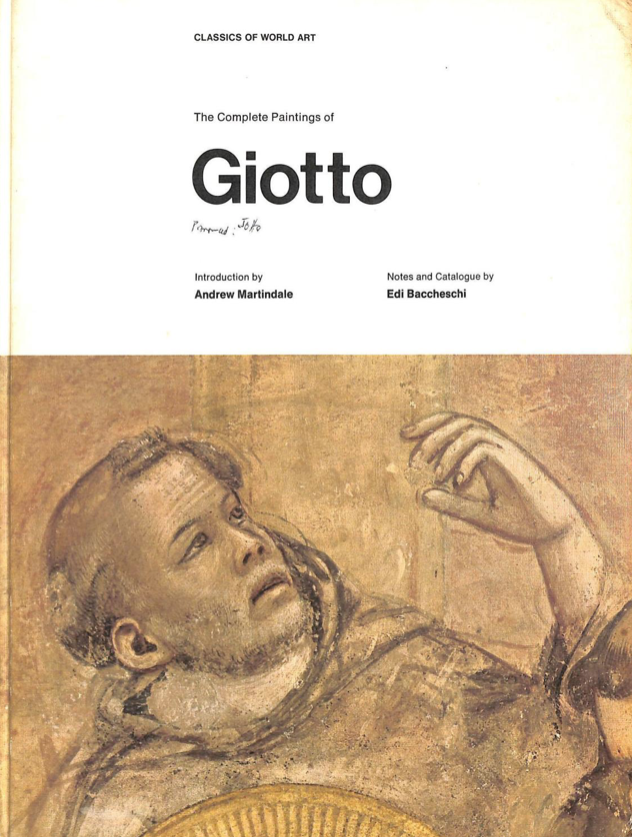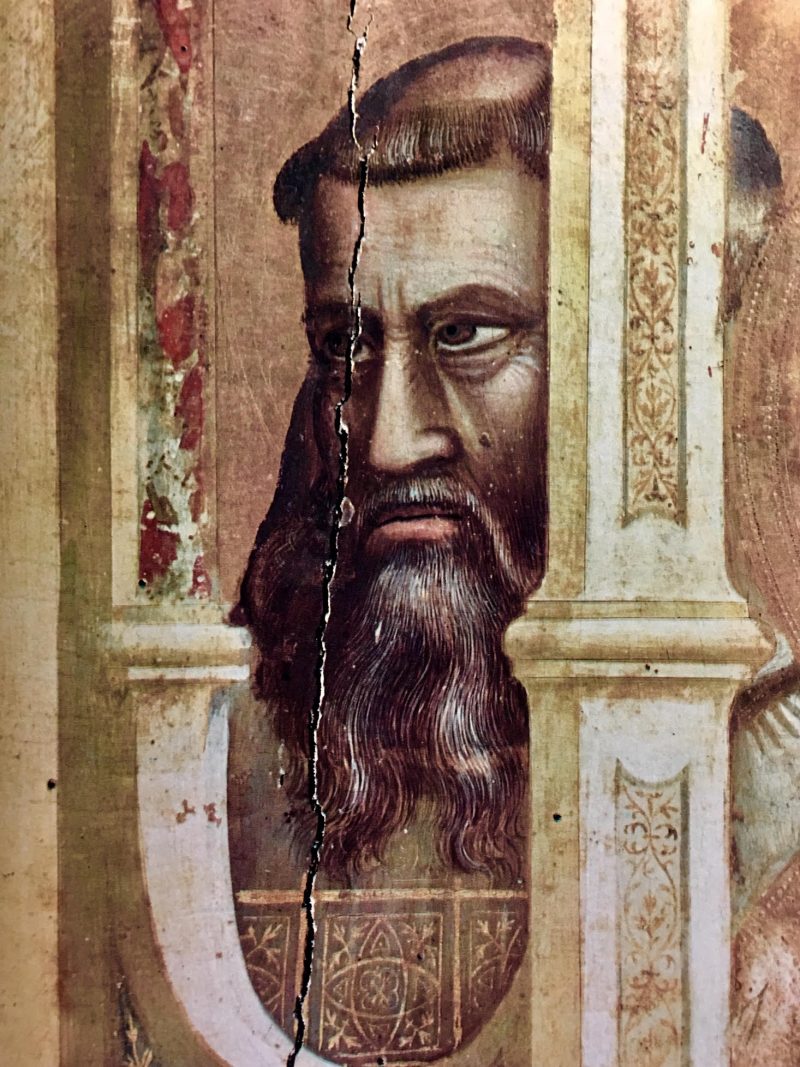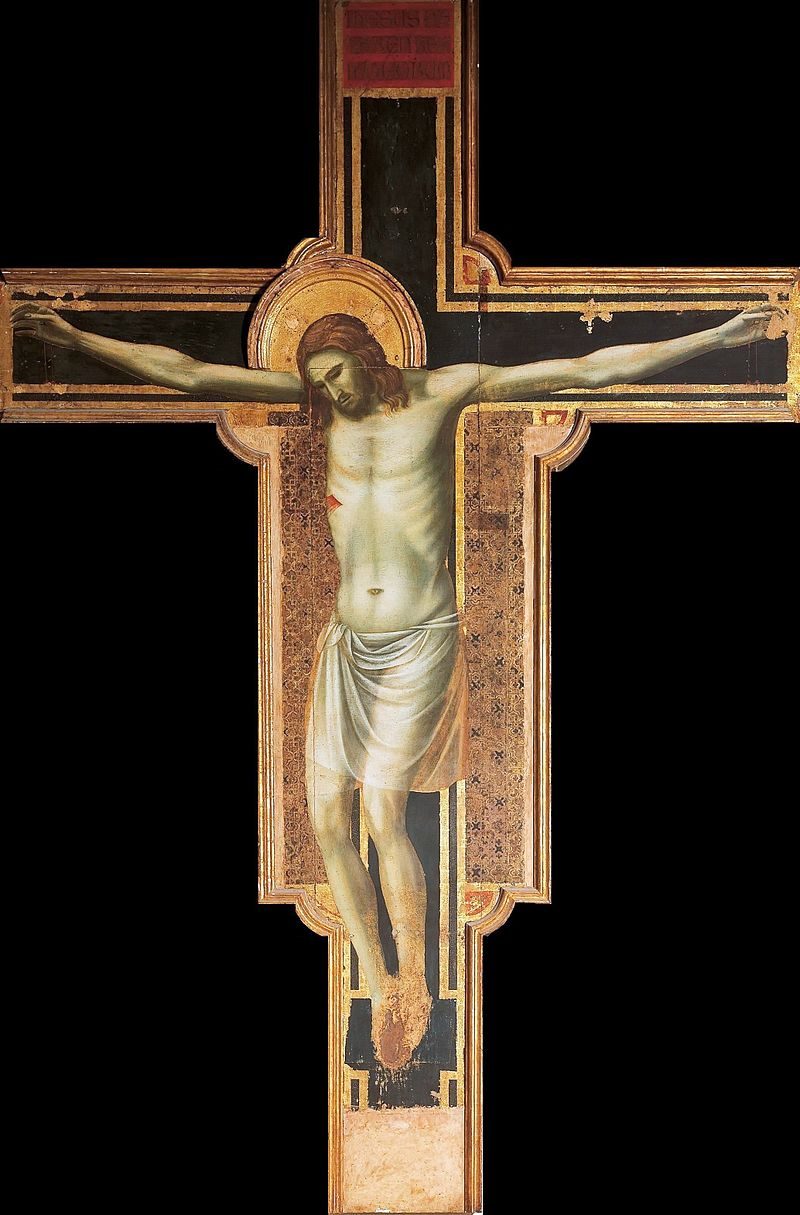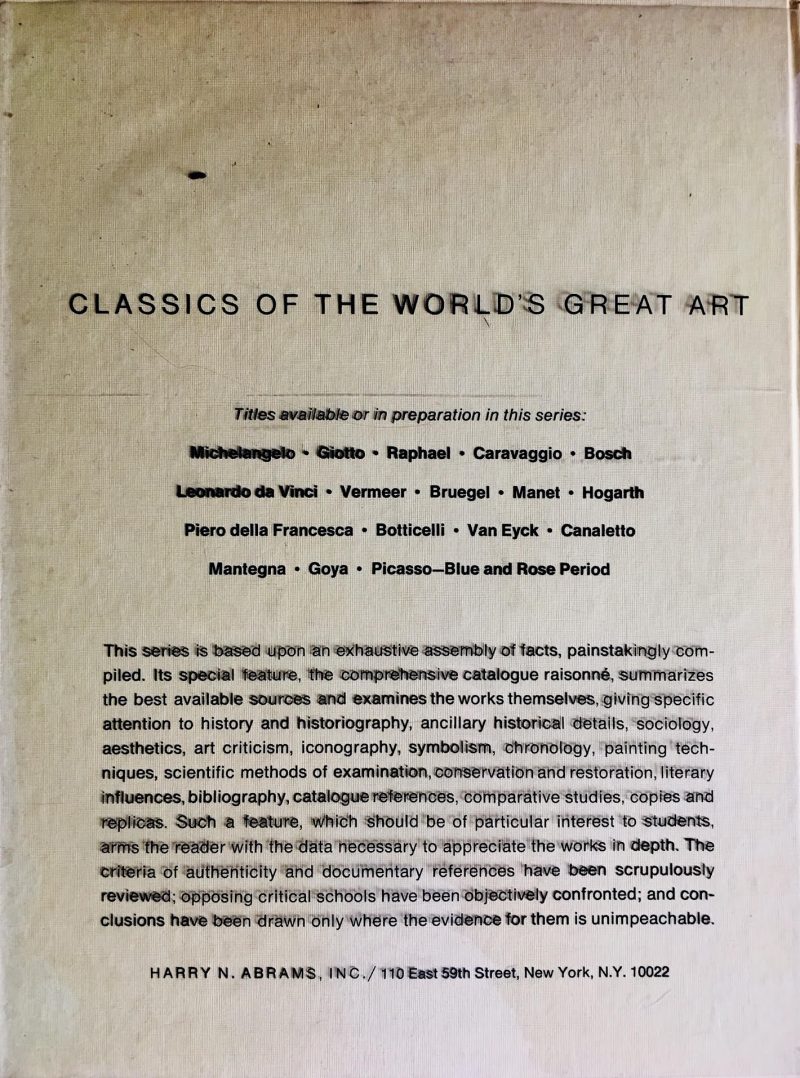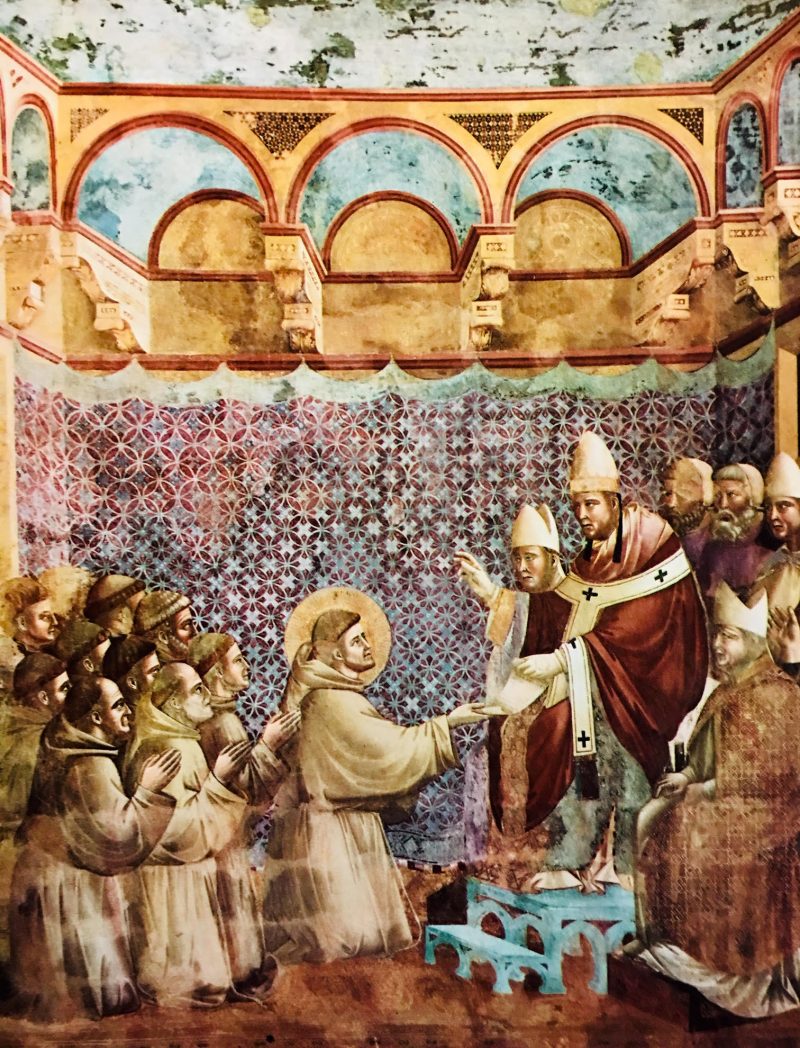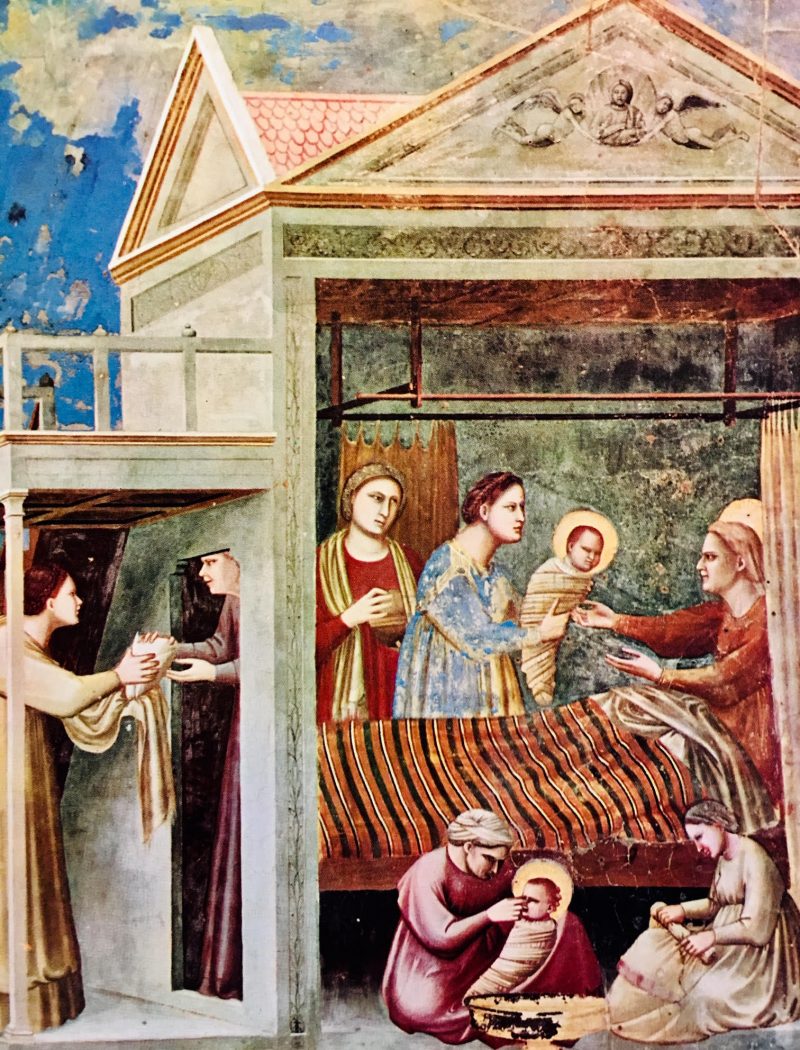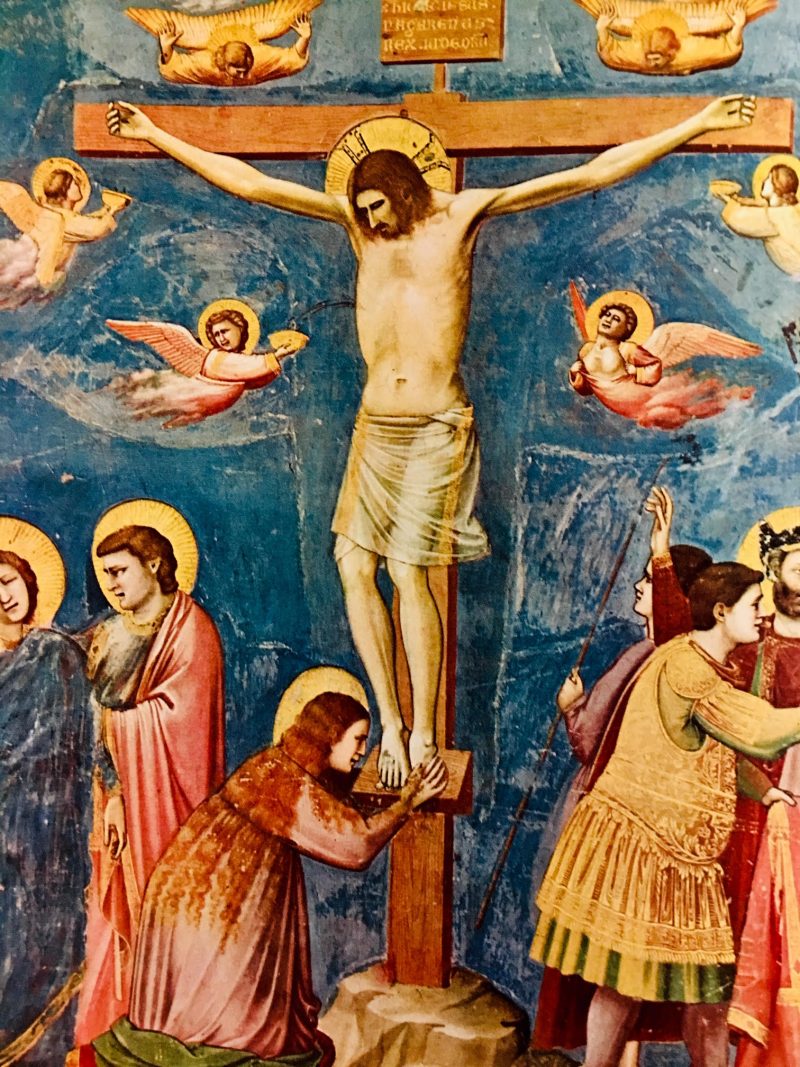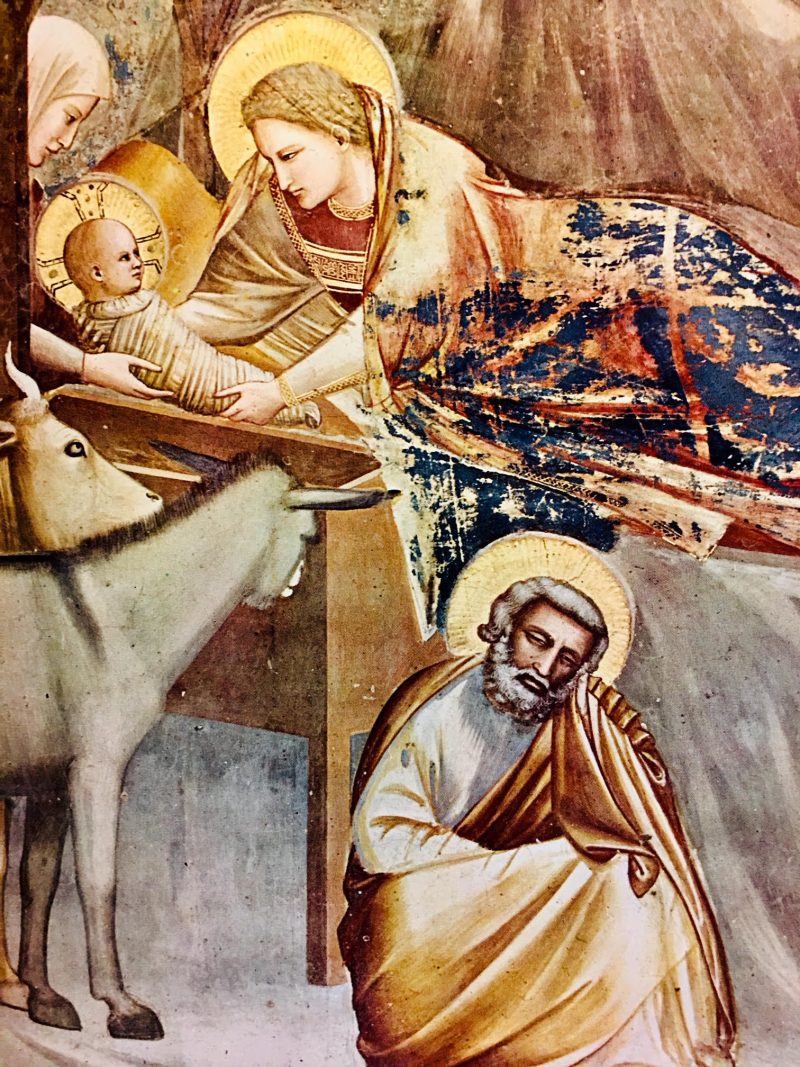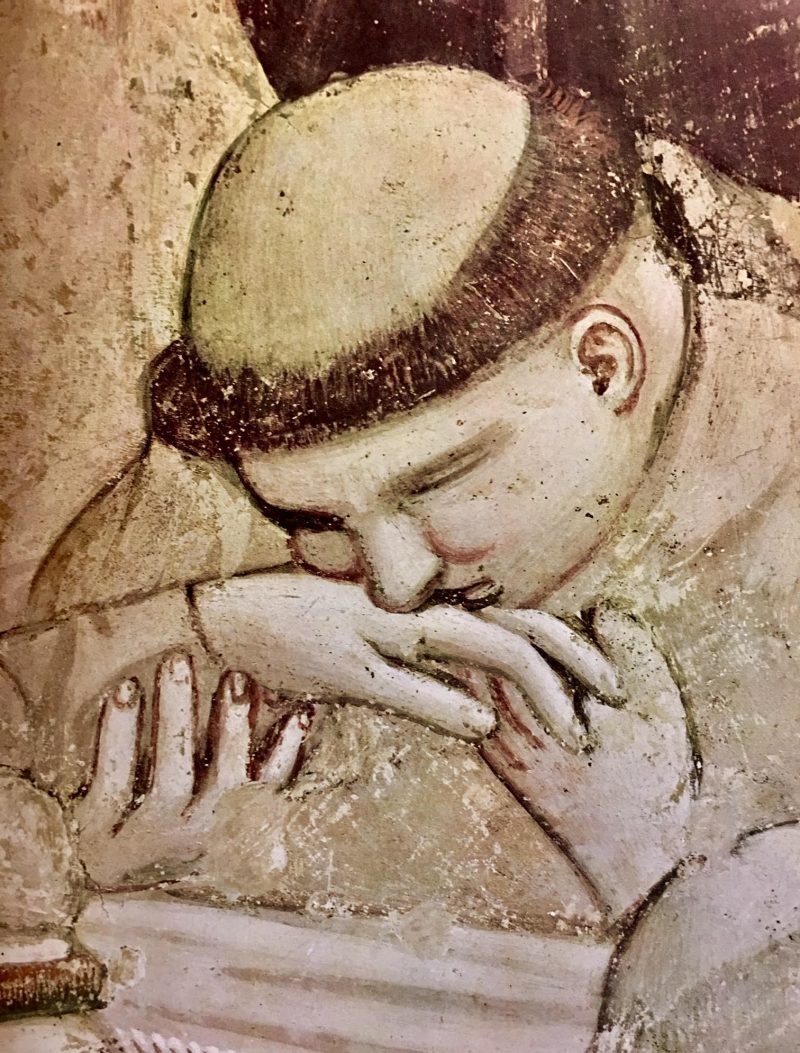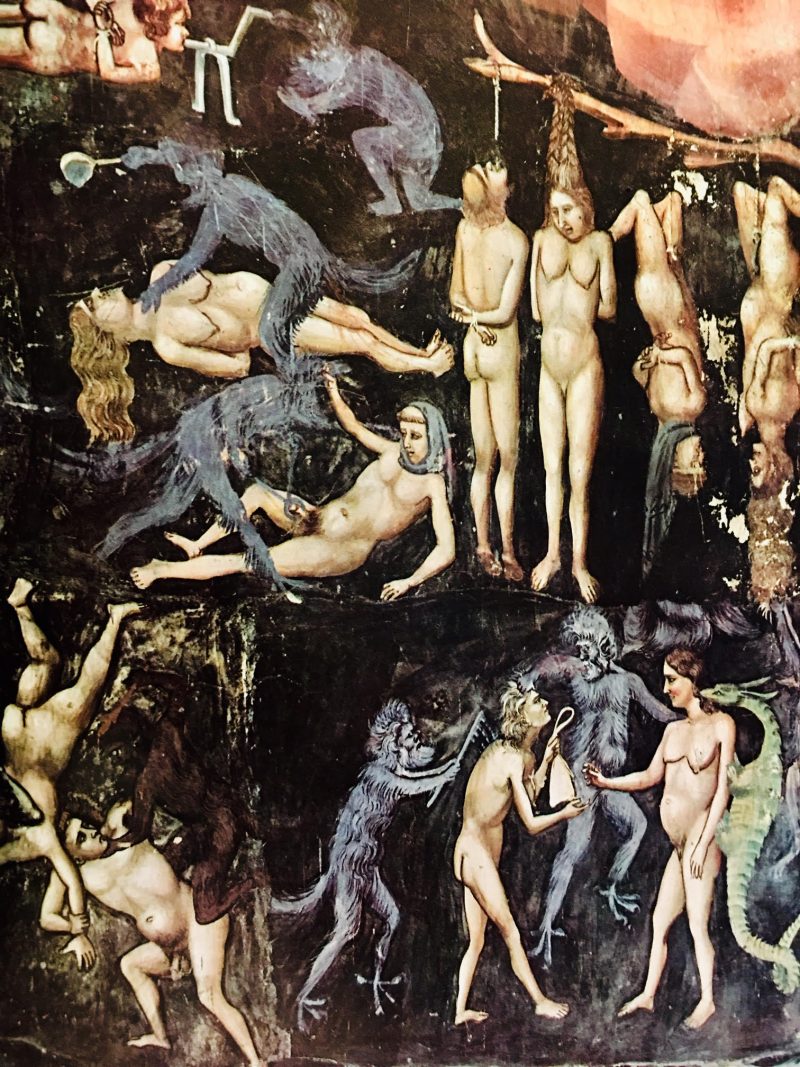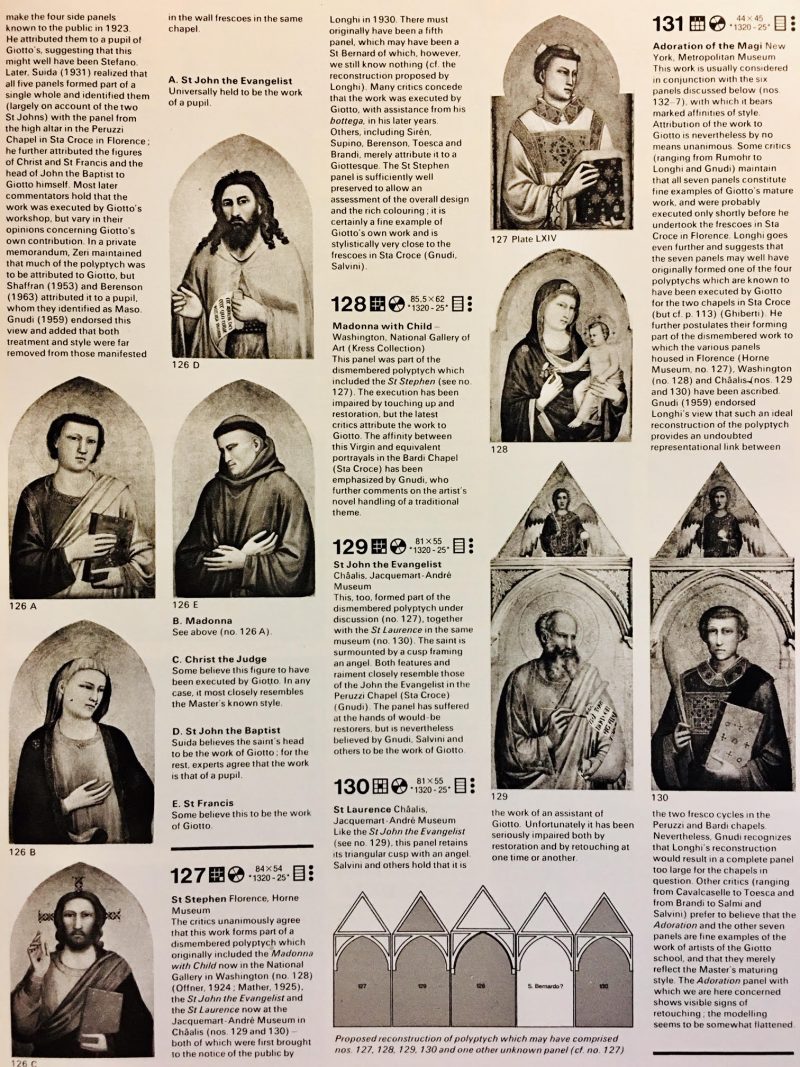SOLD. The Complete Paintings of Giotto Hardcover – 1966
SOLD.
The Complete Paintings of Giotto Hardcover – 1966
New York: Harry N. Abrams, 1966. Hardcover Book. Measures 9.5 inches width x 12.25 inches height. Asking $55
Title: The Complete Paintings of Giotto
Publisher: Weidenfeld Nicholson
Publication Date: 1969
Binding: Hardcover
Book Condition: Used: Good
Dust Jacket Condition: No Jacket
| Giotto di Bondone | |
|---|---|
| Possible image of Giotto from the Peruzzi Chapel (digitally restored) | |
| Born | Giotto di Bondone c. 1267 near Florence, Republic of Florence (present-day Italian Republic) |
| Died | January 8, 1337 (aged 69–70) Florence, Republic of Florence |
| Nationality | Italian |
| Known for | Painting, fresco, architecture |
| Notable work | Scrovegni Chapel frescoes, Campanile |
| Movement | Late Gothic Proto-Renaissance |
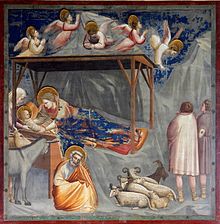
Nativity, from the Scrovegni Chapel
Giotto di Bondone (Italian pronunciation: [ˈdʒɔtto di bonˈdoːne]; c. 1267 – January 8, 1337), known mononymously as Giotto (UK: /ˈdʒɒtoʊ/, US: /dʒiˈɒtoʊ, ˈdʒɔːtoʊ/) and Latinised as Giottus, was an Italian painter and architect from Florence during the Late Middle Ages. He worked during the Gothic/Proto-Renaissance period.[
Giotto’s contemporary, the banker and chronicler Giovanni Villani, wrote that Giotto was “the most sovereign master of painting in his time, who drew all his figures and their postures according to nature” and of his publicly recognized “talent and excellence”.[
In his Lives of the Most Excellent Painters, Sculptors, and Architects, Giorgio Vasari described Giotto as making a decisive break with the prevalent Byzantinestyle and as initiating “the great art of painting as we know it today, introducing the technique of drawing accurately from life, which had been neglected for more than two hundred years”.[
Giotto’s masterwork is the decoration of the Scrovegni Chapel, in Padua, also known as the Arena Chapel, which was completed around 1305. The fresco cycle depicts the Life of the Virgin and the Life of Christ. It is regarded as one of the supreme masterpieces of the Early Renaissance.[
That Giotto painted the Arena Chapel and that he was chosen by the Commune of Florence in 1334 to design the new campanile (bell tower) of the Florence Cathedral are among the few certainties about his life. Almost every other aspect of it is subject to controversy: his birth date, his birthplace, his appearance, his apprenticeship, the order in which he created his works, whether or not he painted the famous frescoes in the Upper Basilica of Saint Francis in Assisi and his burial place.
Tradition holds that Giotto was born in a farmhouse, perhaps at Colle di Romagnano or Romignano.Since 1850, a tower house in nearby Colle Vespignano has borne a plaque claiming the honor of his birthplace, an assertion that is commercially publicized. However, recent research has presented documentary evidence that he was born in Florence, the son of a blacksmith. His father’s name was Bondone. Most authors accept that Giotto was his real name, but it is likely to have been an abbreviation of Ambrogio (Ambrogiotto) or Angelo (Angelotto).[
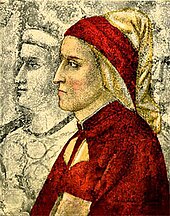
A portrait of Dante by Giotto
The year of his birth is calculated from the fact that Antonio Pucci, the town crier of Florence, wrote a poem in Giotto’s honour in which it is stated that he was 70 at the time of his death. However, the word “seventy” fits into the rhyme of the poem better than any longer and more complex age so it is possible that Pucci used artistic license.[
Vasari states that Giotto was a shepherd boy, a merry and intelligent child who was loved by all who knew him. The great Florentine painter Cimabue discovered Giotto drawing pictures of his sheep on a rock. They were so lifelike that Cimabue approached Giotto and asked if he could take him on as an apprentice.[ Cimabue was one of the two most highly renowned painters of Tuscany, the other being Duccio, who worked mainly in Siena.
Vasari recounts a number of such stories about Giotto’s skill as a young artist. He tells of one occasion when Cimabue was absent from the workshop, and Giotto painted a remarkably lifelike fly on a face in a painting of Cimabue. When Cimabue returned, he tried several times to brush the fly off.[13]
Vasari also relates that when the Pope sent a messenger to Giotto, asking him to send a drawing to demonstrate his skill, Giotto drew a red circle so perfect that it seemed as though it was drawn using a pair of compasses and instructed the messenger to send it to the Pope. The messenger departed ill pleased, believing that he had been made a fool of. The messenger brought other artists’ drawings back to the Pope in addition to Giotto’s. When the messenger related how he had made the circle without moving his arm and without the aid of compasses the Pope and his courtiers were amazed at how Giotto’s skill greatly surpassed all of his contemporaries.[
Many scholars today are uncertain about Giotto’s training and consider Vasari’s account that he was Cimabue’s pupil as legend; they cite earlier sources that suggest that Giotto was not Cimabue’s pupil.[
About 1290, Giotto married Ciuta (Ricevuta), the daughter of Lapo del Pela of Florence. The marriage produced four daughters and four sons, one of whom became a painter.[ By 1301, Giotto owned a house in Florence, and when he was not traveling, he would return there and live in comfort with his family.
Cimabue went to Assisi to paint several large frescoes at the new Basilica of Saint Francis of Assisi, and it is possible but not certain that Giotto went with him. The attribution of the fresco cycle of the Life of St. Francis in the Upper Church has been one of the most disputed in art history. The documents of the Franciscan Friars that relate to artistic commissions during this period were destroyed by Napoleon‘s troops, who stabled horses in the Upper Church of the Basilica, so scholars have debated the attribution to Giotto. In the absence of documentary evidence to the contrary, it has been convenient to ascribe every fresco in the Upper Church that was not obviously by Cimabue to Giotto, whose prestige has overshadowed that of almost every contemporary.

One of the Legend of St. Francisfrescoes at Assisi, the authorship of which is disputed.
An early biographical source, Riccobaldo Ferrarese, mentions that Giotto painted at Assisi but does not specify the St Francis Cycle: “What kind of art [Giotto] made is testified to by works done by him in the Franciscan churches at Assisi, Rimini, Padua…” Since the idea was put forward by the German art historian, Friedrich Rintelen in 1912,[ many scholars have expressed doubt that Giotto was the author of the Upper Church frescoes.
Without documentation, arguments on the attribution have relied upon connoisseurship, a notoriously unreliable “science”,[ but technical examinations and comparisons of the workshop painting processes at Assisi and Padua in 2002 have provided strong evidence that Giotto did not paint the St. Francis Cycle. There are many differences between the Francis Cycle and the Arena Chapel frescoes that are difficult to account for within the stylistic development of an individual artist. It is now generally accepted that four different hands are identifiable in the Assisi St. Francis frescoes and that they came from Rome. If this is the case, Giotto’s frescoes at Padua owe much to the naturalism of the painters.
The authorship of a large number of panel paintings ascribed to Giotto by Vasari, among others, is as broadly disputed as the Assisi frescoes.[ According to Vasari, Giotto’s earliest works were for the Dominicans at Santa Maria Novella. They include a fresco of The Annunciation and the enormous suspended Crucifix, which is about 5 metres (16 feet) high. It has been dated to about 1290 and is thought to be contemporary with the Assisi frescoes. Earlier attributed works are the San Giorgio alla Costa Madonna and Child, now in the Diocesan Museum of Santo Stefano al Ponte, Florence, and the signed panel of the Stigmatization of St. Francishoused in the Louvre.
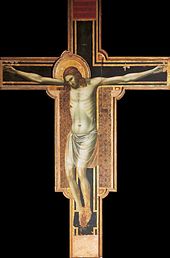
The Crucifixion of Rimini
In 1287, at the age of about 20, Giotto married Ricevuta di Lapo del Pela, known as “Ciuta”. The couple had numerous children (perhaps as many as eight), one of whom, Francesco, became a painter.[ Giotto worked in Rome in 1297–1300, but few traces of his presence there remain today.
The Archbasilica of St. John Lateran houses a small portion of a fresco cycle, painted for the Jubilee of 1300 called by Boniface VIII. In this period Giotto also painted the Badia Polyptych, now in the Uffizi, Florence.[
Giotto’s fame as a painter spread. He was called to work in Padua and also in Rimini, where there remains only a Crucifix painted before 1309 and conserved in the Church of St. Francis. It influenced the rise of the Riminese school of Giovanni and Pietro da Rimini. According to documents of 1301 and 1304, Giotto by this time possessed large estates in Florence, and it is probable that he was already leading a large workshop and receiving commissions from throughout Italy.[
